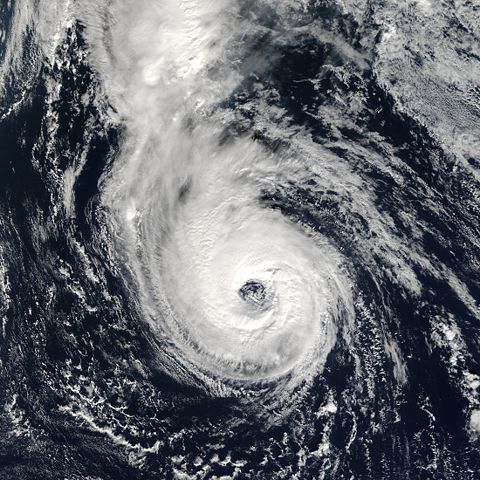From Wikipedia, the free encyclopedia
 Size of this preview: 480 × 480 pixels
Size of this preview: 480 × 480 pixels Full resolution (4,400 × 4,400 pixels, file size: 4.66 MB, MIME type: image/jpeg)
 |
This is a file from the Wikimedia Commons. The description on its description page there is shown below.Commons is a freely licensed media file repository. You can help.
|
Summary
| Description |
The official hurricane season in the Atlantic Ocean runs from June 1 to November 30 each year, but on very rare occasions, tropical storms and even hurricanes form outside the season. In 150 years of records, a hurricane has formed outside of the season on only four other occasions. But with so many records broken by the 2005 Atlantic hurricane season, it seems almost unsurprising to find Hurricane Epsilon ushering in December and bumping that out-of-season-hurricane record up to five storms. Epsilon formed in the Central Atlantic about halfway between the Azores Islands and Bermuda on November 29, 2005. This image shows Hurricane Epsilon in the mid-Atlantic, as observed by the Moderate Resolution Imaging Spectroradiometer (MODIS) on the Terra satellite on December 4, 2005, at 13:30 UTC (10:30 a.m. local time). At that time, the hurricane had peak sustained winds of 140 kilometers per hour (85 miles per hour). That intensity appears to be the strongest the storm will achieve, according to forecasts from early on December 5, 2005. The storm had been sustaining winds from 120-140 kilometers per hour (75-85 mph) for roughly 48 hours at that time. This longevity ensures that Epsilon, despite having four other storms for company in the out-of-season-hurricane neighbourhood, will nevertheless go down alone in the record books in at least one respect: it has broken a new record for the longest-lived December hurricane. |
| Source |
http://earthobservatory.nasa.gov/NaturalHazards/natural_hazards_v2.php3?img_id=13272 |
| Date |
2005-12-04 |
| Author |
NASA image courtesy Jeff Schmaltz, MODIS Rapid Response Team,Goddard Space Flight Centre |
Permission
( Reusing this image) |
|
|
This file is in the public domain because it was created by NASA. NASA copyright policy states that "NASA material is not protected by copyright unless noted". ( NASA copyright policy page or JPL Image Use Policy).
Deutsch | English | Español | Français | Galego | Nederlands | Português | Русский | 中文(简体) | 中文(繁體) | +/- |
|
|
|
Warnings:
- Use of NASA logos, insignia and emblems are restricted per US law 14 CFR 1221.
- The NASA website hosts a large number of images from the Soviet/ Russian space agency, and other non-American space agencies. These are not necessarily in the public domain.
- Materials from the Hubble Space Telescope may be copyrighted if they do not explicitly come from the STScI.
- All materials created by the SOHO probe are copyrighted and require permission for commercial non-educational use.
- Images featured on the Astronomy Picture of the Day (APOD) web site may be copyrighted.
|
|
File history
Click on a date/time to view the file as it appeared at that time.
|
|
Date/Time |
Dimensions |
User |
Comment |
| current |
23:40, 29 September 2006 |
4,400×4,400 (4.66 MB) |
Good kitty |
|
|
|
15:25, 10 May 2006 |
4,400×4,400 (4.02 MB) |
Platonides |
|
File links
The following pages on Schools Wikipedia link to this image (list may be incomplete):


